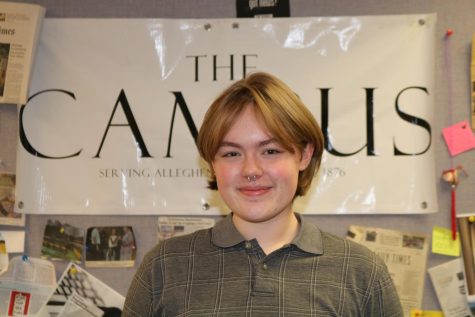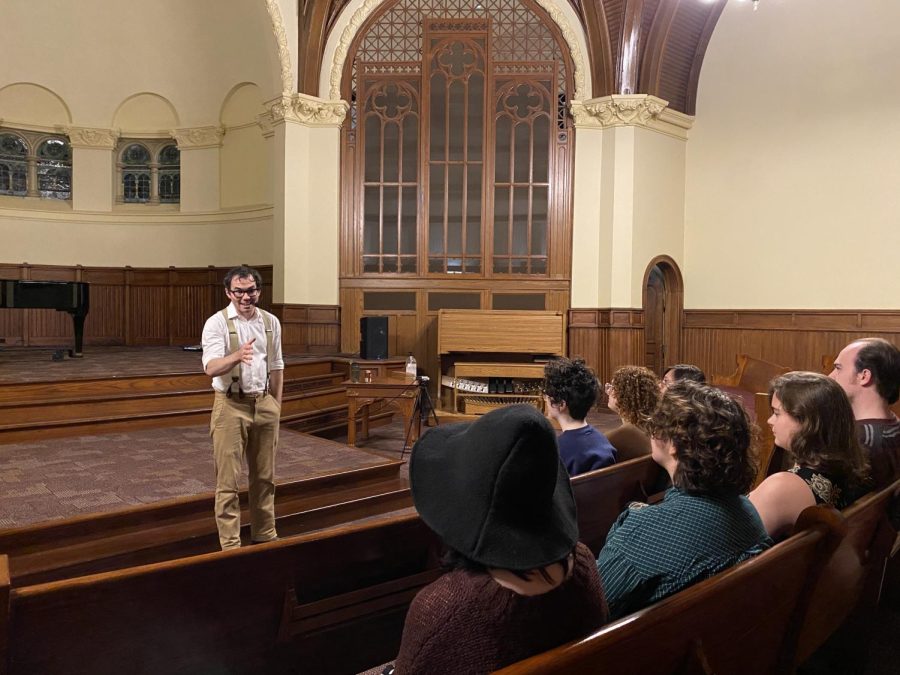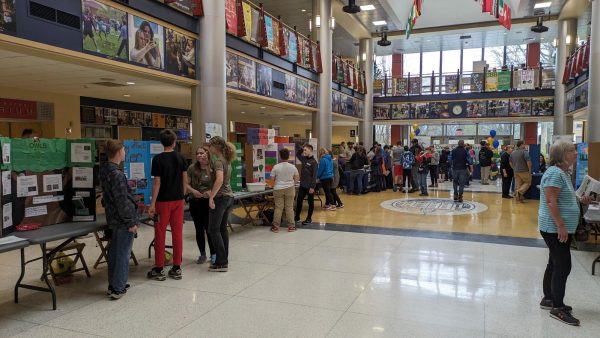“Ghost Stories” by Doctor Sparks blends local history with fiction
It was a dark and stormy night as students and professors filtered into Ford Chapel to listen to the “Ghost Stories” of Karl Smith, ’11. After a brief rehearsal and some technical adjustments, Smith — or “Doctor Sparks,” as he is known in his performances — took to the stage.
Though Smith is a professional storyteller who has made a living from his craft, he traditionally performs for a younger audience. At Allegheny, Smith studied English and physics. On his website, he describes himself as “Mister Rogers meets Bill Nye,” giving science lessons through original stories. Ghost Stories was its own kind of performance, reminiscent of Smith’s experience as a historical interpreter in New Mexico.
“I love telling stories to kids,” Smith said. “It’s really fun. But I really missed the dark, dramatic storytelling I used to do in front of a campfire.”
Hosted by the Student Experimental Theater on Nov. 11 and Saturday, Nov. 12, the show blended fact and fiction, as well as personal and local history. Each of the stories took place at Lake Arthur in Moraine State Park. Some of the characters in the stories were former Allegheny students, while others were members of Smith’s family. Each story was based in the true history of Lake Arthur, which is 55 miles south of Meadville, but exaggerated some elements to build a narrative.
“I was really excited to do something for an adult audience, and to incorporate a lot of my own family’s history — and a lot of the research that I’ve done about (Lake Arthur) — into this ghost storytelling show,” Smith said.
Prior to his career as a professional storyteller, Smith was still finding ways to combine his love of science and storytelling — something, he says, that was encouraged during his time as an Allegheny student. His interdisciplinary interest in both English and physics was something that Smith brought to the college experience, but was nevertheless developed as an undergraduate.
“The idea of science storytelling, that I would find a way to merge these two things together — it came directly out of the Allegheny experience, I think,” Smith said.
The encouragement to merge those different interests came from both of Smith’s undergraduate advisers: Professor of Physics Doros Petasis and Professor of English Ben Slote. Both advisers helped Smith realize that his two distinct interests, biophysics and storytelling, could make for an interesting career.
Slote in particular, who helped organize the Ghost Stories event, emphasized Smith’s ability to not just think, but rather to exist, outside of the box. As someone who went on to receive his biophysics Ph.D. and start his own storytelling business, Smith met the “unusual combinations” standard of Allegheny.
“We think of ourselves as having to go out and fit into the little boxes that are out there, and Karl, to his great credit, had the desire to keep trying to push into the world a space that actually conformed to him, not the other way around,” Slote said.
According to Slote, Smith’s various interests were something that led him to, and were ultimately enriched by, the Allegheny experience. As an English professor, Slote was able to witness first-hand the passion Smith had for storytelling, and knew that, since Smith was also focused on scientific courses, he fulfilled the Allegheny question, “Why be just one thing?”
“He’s a great embodiment of something that seems very Allegheny to me, which is you don’t have to let go of those other sides of yourself,” Slote said.
Even beyond his time at Allegheny, Smith sought to keep both of his passions alive. Pursuing a biophysics Ph.D. did not offer much room for storytelling, so Smith had to get creative.
“Whenever I went to graduate school, there was very little opportunity to tell stories, and so I had to find some way to keep that creative side of myself alive,” Smith explained.
The solution? Writing stories for a dime, for anyone who cared to talk. Smith would ask for a prompt from passersby and craft a story for them using his typewriter. The experience was a novel way to develop his creativity as a storyteller and meet new people.
“(The experience) has been consistently one of the most beautiful, strange, whimsical things I’ve ever been privileged to do,” Smith said.
His career as a professional storyteller seemed like an inevitability. After working through various mediums to tell his stories — including a television pilot aired shortly after graduate school — it appeared that stage performance was the best way to engage and connect with his audience. Given that Smith enjoyed performing for kids most of all, a stage show was a way to engage his audience even more.
“It became this stage show which actually made much more sense for the audience that I was targeting,” Smith said.
But on that stormy night, “Doctor Sparks” had returned to his roots for “Ghost Stories,” performing, this time as an educator, the stories that started during his time as a student. The hour-long collection of storie s were woven together with equal parts suspense, history and fictional liberty. One story of a 1960’s teenage romance connected to a story of the attempt to catch an elusive, 72-foot-long catfish, and both stories tied back to the story of a mysterious murder that took place a century prior. Doctor Sparks’ animated-yet-suspenseful style of storytelling captivated the audience in the chapel.
Students highlighted the original style of Karl Smith’s performance, pointing out the uniqueness of a story that blended fact and fiction, across overlapping timelines.
“I was drawn in the entire time, and I hung onto every word that he said,” said Victoria Smith, ’23.
Doctor Sparks’ performance ended with a round of applause and a thank-you to Slote and the members of SET. He talked about the research that went into crafting his stories — that many of the people were real, even if the content of the stories, he joked, “may not have happened that way.”
Smith’s other work can be found on his website, doctorsparks.com.

Sam Heilmann is a sophomore from Johnstown, PA. She is double-majoring in Communications and Environmental Science and Sustainability. This is her second...







